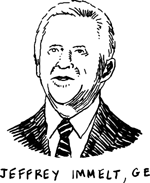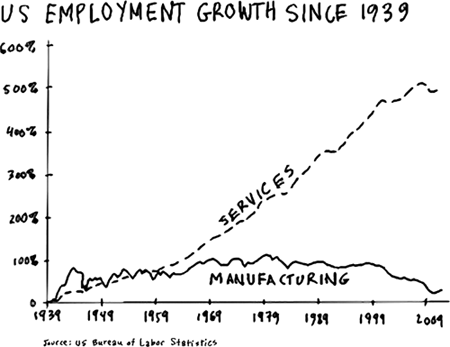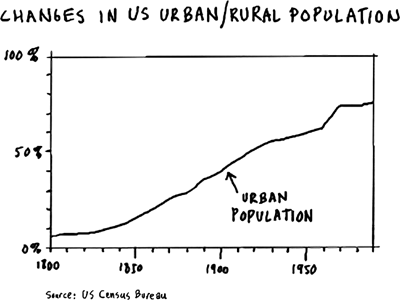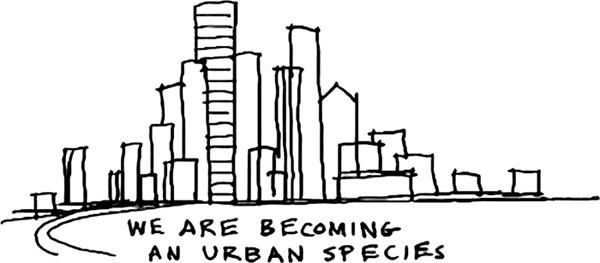Out with the industrial economy, in with the service economy
The majority of business growth in the coming decades—new jobs and new businesses—will come from services.
 Apis florea nest closeup. (source: By Sean Hoyland on Wikimedia Commons)
Apis florea nest closeup. (source: By Sean Hoyland on Wikimedia Commons)
In today’s world, where ideas are increasingly displacing the
physical in the production of economic value, competition for
reputation becomes a significant driving force, propelling our economy
forward. Manufactured goods often can be evaluated before the
completion of a transaction. Service providers, on the other hand,
usually can offer only their reputations.Alan Greenspan
Industrialization is a phase, and in developed nations that phase
is ending. Growth in developed economies will increasingly come from
services.
The Great Reset
In The Great Reset: How New Ways of Living and
Working Drive Post-Crash Prosperity, Richard Florida points to a shift from an economy based on
making things to one that is increasingly powered by knowledge,
creativity, and ideas:
Great Resets are broad and fundamental transformations
of the economic and social order and involve much more than strictly
economic or financial events. A true Reset transforms not simply the
way we innovate and produce but also ushers in a whole new economic
landscape.
Jeffrey Immelt, CEO of General Electric, agrees:
This economic crisis doesn’t represent a cycle. It represents
a reset. It’s an emotional, raw social, economic reset. People who
understand that will prosper. Those who don’t will be left
behind.

The good news is that although resets are initiated by
failures—sometimes catastrophic failures, like we have seen in the
mortgage system—they also lead to new periods of growth and
innovation, built on new systems and infrastructure.
There’s little doubt that a fundamental economic restructuring
is underway. There will be winners and there will be losers.
An Age of Abundance
As we stand on the verge of a new era, it’s easy to disparage
the old-school industrial economy. But let’s not forget that the
industrial economy gave us an abundance of material wealth we now take
for granted, including many things that were unavailable—and
unimaginable—in previous centuries.
Economist J. Bradford DeLong points out that in 1836, the richest man in the
world, Nathan Rothschild, died of a common infection that would have
been easily curable with modern antibiotics.
In the 1890s, even the richest of the rich could not go to the
movies or watch football on TV, and traveling from New York to Italy
took at least a week.
The material abundance we all enjoy was made possible by an
industrial economy that focused primarily on mass-producing material
goods. The philosophy of mass production was based on Henry Ford’s big idea: If you could produce great volumes of a
product at a low cost, the market for that product would be virtually
unlimited. In the early days, his idea held true, but eventually,
every market gets saturated and it gets more and more difficult to
sell more stuff. By 1960, 70% of families owned their own homes, 85%
had a TV, and 75% had a car.
As markets became saturated with material goods, producers found
a new way to apply the principle of mass production in mass marketing. With a TV in nearly every house,
producers had a direct line to customers. Customers became known as
consumers, because their role in the economy was to consume everything that producers could
make. Increasingly, this producer-consumer economy developed into a marketing-industrial complex
dependent on consumer dissatisfaction and the mass creation of desire for the next new thing.
New technologies of communication have splintered the channels
of mass communication into tiny fragments. It’s no longer possible for
mass marketers to reach out and touch all of their customers at once.
The megaphone is gone. And with the rise of blogs, social networks and
other peer-to-peer communication channels, every customer can have his
own megaphone.
To many mass marketers, this feels like a chaotic cacophony of
voices, and it’s hard to be heard in the crowd. But to most customers,
it’s an empowering feeling to have a voice, to be heard. Even if a
company ignores your complaint, the world will hear, and if companies
don’t respond, they will eventually feel the pain, as customers find
new places to go to get what they want.
The producer-driven economy is giving way to a new,
customer-centered world in which companies will prosper by developing
relationships with customers—by listening to them, adapting, and
responding to their wants and needs.
The problem is that the organizations that generated all this
wealth were not designed to listen, adapt, and respond. They were
designed to create a ceaseless, one-way flow of material goods and
information. Everything about them has been optimized for this
one-directional arrow, and product-oriented habits are so deeply
embedded in our organizational systems that it will be difficult to
root them out.

It’s not only companies that need to change. Our entire society
has been optimized for production and consumption on a massive scale.
Our school systems are optimized to create good cogs for the corporate
machine, not the creative thinkers and problem-solvers we will need in
the 21st century. Our government is optimized for corporate customers,
spending its money to bail out and protect the old infrastructure
instead of investing in the new one. Our suburbs are optimized to
increase consumption, with lots of space for products and plenty of
nearby places where we can consume more stuff—including lots of
fuel—along the way. Our entertainment and advertising industries are
designed to drive demand and keep the whole engine running.
While workers are being laid off in many industries, technology
companies like Facebook and Google are suffering from critical
shortages, struggling to fill their ranks and depending heavily on
talent imported from other countries that place a higher priority on
technical education:
The whole approach of throwing trillions of public dollars at
the old economy is shortsighted, aimed at restoring our collective
comfort level. Meaningful recovery will require a lot more than
government bailouts, stimuli, and other patchwork measures designed
to resuscitate the old system or to create illusory, short-term
upticks in the stock market, housing market, or car sales.
–Richard Florida
We no longer live in an industrial economy. We live in a service economy. And to
succeed in a service economy, we will need to develop new habits and
behaviors. And we will need new organizational structures.
An Emerging Service Economy
Since 1960, services have dominated US employment. Today’s
services sector makes up about 80% of the US economy. Services are
integrated into everything we buy and use. Nine out of every ten
companies with fewer than 20 employees are in services. Companies like
GE and IBM, which started in manufacturing, have made the transition,
and now make the majority of their money in services.
What’s driving the move to services? Three things: product
saturation, information technology, and urbanization.

Product Saturation
When people already have most of the material goods they need,
they will tend to spend more of their disposable income on services.
Increasingly, the products that companies want to sell us are
optional; they offer not functionality, but intangible things like
status, pride of ownership, novelty, and so on.
And products, we have found, not only make life easier, but
can also be a burden. When you own a house, you have to spend money
to fix the roof or the plumbing. Where’s the fun in that? And moving
can be a big hassle when you have a truckload of stuff to lug along
with you.
A recent study found that Great Britain, where the industrial revolution began, reached “peak stuff”
levels between 2001 and 2003—long before the 2008 recession—and
material consumption has been declining ever since (it’s now down to
the 1989 level).
Information Technology
A post-industrial revolution is delivering a new kind of
abundance: an abundance of information, along with networks and
mobile devices for moving that information around, and much faster
processing, which allows us to do more interesting kinds of things
with the information we have.
Think about how you use the Web. While at first this shift was
driven by the kinds of things we traditionally think of as
information containers, like pages and images, now it has exploded
to include many things that were previously undocumented: your
network of friends and acquaintances, the things you do, the places
you go, the things you buy and what you think about them. Even your
random, throwaway thoughts are being captured in Foursquare
checkins, tweets, status updates, photo and video uploads, and other
kinds of “data exhaust” that you may not even know you’re
generating, simply by using your phone and other devices.
This digital revolution is ushering in new ways to deliver,
combine, and mix up services, resulting in all kinds of enticing
combinations: streaming music, following other people’s book
highlights, renting strangers’ apartments or cars by the day,
negotiating bargain prices from airlines and 4-star hotels, and much
more.
Urbanization
In addition, there is an increasing trend toward urbanization. Throughout the world, city
populations are growing much faster than rural populations. We are
becoming an urban society and living more urban
lifestyles.
Fifty percent of the world’s population today lives on 2 percent of the earth’s
crust. In 1950, that number was 30%. By 2050, it is expected to be
70%.
Why are people moving to cities? Because cities are where the
action is. There are more jobs—and more kinds of jobs—available in
cities, and even when the same job is available in the country and
the city, the job in the city pays more. Urban workers make, on average, 23% more than rural
workers. And the more highly skilled you are as a worker, the more
you stand to gain financially by moving to a large city.
Also, if you happen to get laid off or your company goes out
of business, it’s much easier to find a new job in a city without
having to pick up and move.
As work becomes more complex and more skills are required,
cities become more attractive to companies, too, because that’s
where the skilled workers are. Cities pack a lot of people and
businesses into a relatively small space, which is good for services
companies in several ways.

Space: People living in
small city apartments just don’t have a lot of room for products,
and because they are making more money than their rural
counterparts, they tend to spend more on services. Why take up space
with a washer and dryer when there’s a laundry service right down
the street?
Density: Urban density makes it more attractive for companies
to provide a wide variety of services. For example, a cable company
can wire a city apartment building and serve hundreds of households
for a fraction of the cost to do the same thing in a suburb or rural
area. Taxis find customers quickly in densely packed urban centers. One city block can support several
specialty stores and a variety of restaurants. And in a reciprocal
loop, that wide variety of services makes cities even more
attractive places to live.
Consider the quintessential industrial-age product, the
automobile: for many, it is a symbol of individuality, status,
personality, and freedom. In suburban and sparsely-populated rural
areas, a car provides you with unlimited mobility and choice. But in
a densely populated urban environment, a car quickly becomes more trouble
than it’s worth. A permanent parking space in New York costs more
than a house in many other areas.
Density creates demand for more services, like taxis, limousine services, buses, and
subways. It also creates opportunities for new services. For
example, Zipcar is a car-sharing service that gives customers shared
access to a pool of cars located throughout their city. RelayRide and
Whipcar are peer-to-peer services that allow car owners to rent
their cars to neighbors by the hour or by the day. Uber connects a
network of professional limo drivers with city dwellers, who can
order a car by SMS or mobile phone app; orders are routed to the
nearest available driver, payments are automated, and driver tips
are included, creating a simple, easy, seamless customer
experience.
Cars themselves will increasingly become platforms for
delivering services. In 1995, GM created OnStar, an in-car subscription service that offers
turn-by-turn directions, hands-free calling, and remote diagnostics.
If your car is stolen, GM can track the vehicle, slow it down, or
shut off the ignition remotely. But that’s just the beginning.
Automakers will increasingly be integrating with digital services,
and cars will become platforms for a broad array of apps and
services that will help you lower your fuel costs, stream music,
avoid collisions, find parking, notify you if friends are near, and
a whole host of other things we can’t yet imagine. Ford announced
recently that they are creating an open platform that will allow
tinkerers and developers to electronically “hot-rod” their cars. And
Google is working on cars that will drive themselves. How’s that for
a service?
If a car can be a service, anything can.

The majority of business growth in the coming decades—new jobs
and new businesses—will come from services.
Some people argue that the majority of services growth comes
from low-wage jobs. But according to the US Bureau of Labor Statistics, job growth will be led by
health care, followed by professional, scientific, and technical
services, as well as education.
